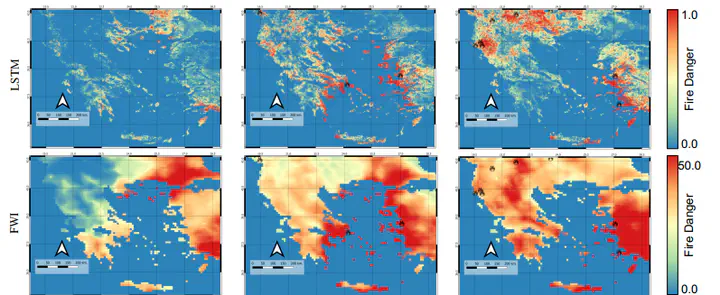
Abstract
Abstract Climate change exacerbates the occurence of extreme droughts and heatwaves, increasing the frequency and intensity of large wildfires across the globe. Forecasting wildfire danger and uncovering the drivers behind fire events become central for understanding relevant climate‐land surface feedback and aiding wildfire management. In this work, we leverage Deep Learning (DL) to predict the next day’s wildfire danger in a fire‐prone part of the Eastern Mediterranean and explainable Artificial Intelligence (xAI) to diagnose model attributions. We implement DL models that capture the temporal and spatio‐temporal context, generalize well for extreme wildfires, and demonstrate improved performance over the traditional Fire Weather Index. Leveraging xAI, we identify the substantial contribution of wetness‐related variables and unveil the temporal focus of the models. The variability of the contribution of the input variables across wildfire events hints into different wildfire mechanisms. The presented methodology paves the way to more robust, accurate, and trustworthy data‐driven anticipation of wildfires. , Plain Language Summary Climate change drives the aggravation of wildfires globally. In this context, it is crucial to better predict and understand wildfires. Our work proposes methods to accurately forecast wildfire danger and hints into the mechanisms that drive it. We use Machine Learning (ML) to predict next‐day wildfire danger, using meteorological, vegetation, and human‐related data, improving the results of the widely used Fire Weather Index, which is based only on meteorological forecasts. We then look to understand what the models have learned and how the different conditioning factors contribute to the final prediction. We find that ML models focus more on soil moisture and relative humidity for their predictions. They also take into account the cumulative temperature and precipitation, as well as the last day’s wind speed and the relative humidity in the 2 days preceding fire ignition. These associations lead to new, data‐driven ways to anticipate wildfires. , Key Points When forecasting fires that lead to large burned areas, Deep Learning models indicate higher predictive skill than the Fire Weather Index Soil moisture, Normalized Difference Vegetation Index, and weather are the most important predictors; changes in their importance across events reveal diverse wildfire types Models’ explainability uncovers physically‐consistent associations and temporal dynamics of the fire drivers
Add the full text or supplementary notes for the publication here using Markdown formatting.